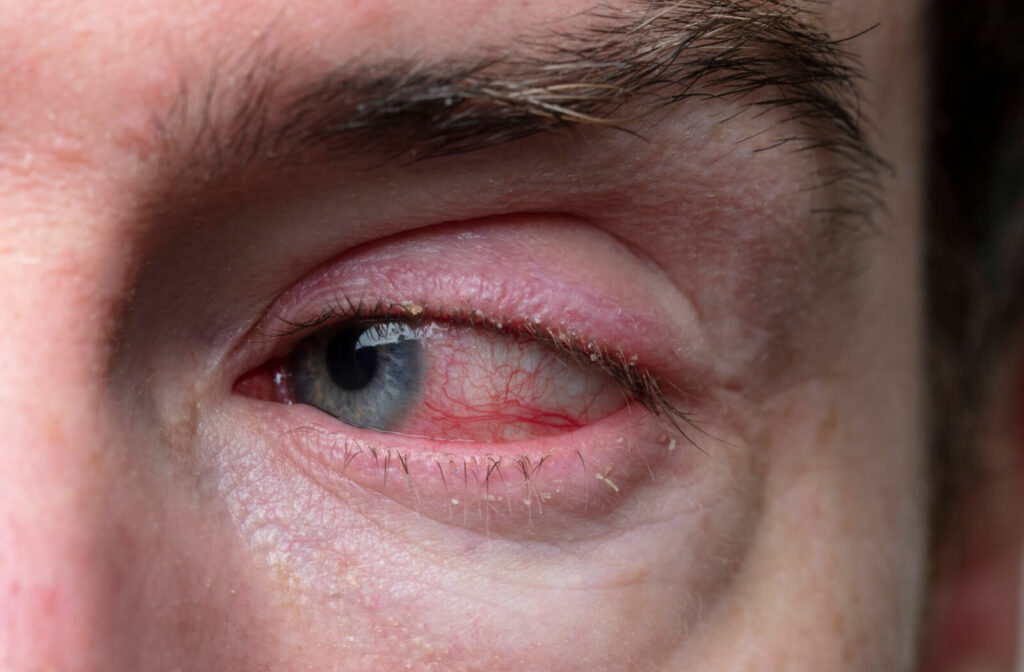Blepharitis is an eye condition that causes inflammation of the eyelids. It can be unsightly and cause discomfort, but unlike pink eye, it’s not contagious and doesn’t spread from person to person.
Blepharitis is a common eyelid condition that occurs in 37–50% of people at some point. While it rarely causes long-term damage to the eye, you should seek treatment from your eye doctor if symptoms persist despite self-care measures.
What Is Blepharitis?
Blepharitis is a chronic condition, meaning it doesn’t completely go away. Inflammation of the eyelids occurs when the tiny oil glands in your eyelids become clogged.
It can affect both eyes at the edge of the eyelids and is a common cause of dry eyes. Symptoms of blepharitis can include the following:
- Watery eyes
- Red eyes
- Eye irritation
- Burning or stinging sensation
- Itchy eyelids
- Red, swollen eyelids
- Flaking of skin around the eyes
- Crusted eyelashes
- Eyelid sticking
- Frequent blinking
- Sensitivity to light
- Blurred vision
Blepharitis Is Not Contagious
Bacterial infection or bacterial overgrowth is the most common cause of blepharitis. These bacteria are present on most people’s skin in normal amounts. This bacteria only causes problems when it overgrows, so you cannot catch blepharitis from someone.
What Causes Blepharitis?
The exact cause of blepharitis is unknown, but there can be various contributing factors, including:
- A blocked or malfunctioning oil gland
- Allergies to makeup, contact lens solution, or other eye products
- Bacterial infection
- Skin conditions such as seborrheic dermatitis, rosacea, and eczema
- Eyelash mites or lice may interfere with oil production (but this is rare)
Types of Blepharitis
There are 2 types of blepharitis, and individuals can have one or both types at the same time:
Anterior Blepharitis
This type affects the outside of the eye where your eyelashes meet your eyelid. Bacteria from your skin or dandruff from your scalp and eyebrows can cause anterior blepharitis.
Posterior Blepharitis
This type affects the edge of the eyelid that touches your eye. When skin conditions such as rosacea and scalp dandruff clog the eyelid’s oil glands, this can cause posterior blepharitis.
Complications of Blepharitis
Other eye problems you can have with blepharitis include:
- Eyelash problems—Eyelashes can fall out, lose color, or misdirected lashes can grow.
- Eyelid skin problems—You can get scarring on your eyelids, or the edges might turn inward or outward.
- Watery or dry eyes—Abnormal tear film can cause excess tearing or dry eyes and irritation.
- Stye—A painful lump near the base of the eyelashes.
- Chronic pink eye—Blepharitis can lead to recurrent pink eye infections (conjunctivitis).
- Injury to the cornea—Constant irritation can cause a sore on your cornea, and lack of tears could increase your risk of a corneal infection.
Since you can’t always pinpoint the cause, a proper diagnosis by your eye doctor is essential for treating and managing blepharitis.

Blepharitis Treatment
Treatment for blepharitis usually includes good hygiene to keep the eyelids clean and free of crusts:
- Use a warm compress over your closed eye to loosen the crusty deposits on your eyelids.
- Gently massage the eyelids with a clean washcloth or a clean finger.
- Wash oily debris or scales with a clean washcloth or cotton-tipped applicator dipped in warm water with a few drops of diluted baby shampoo or an over-the-counter eyelid cleanser.
- Lift the eyelid away from your eye and gently rub the base of the lashes with a washcloth. Lifting helps to avoid damaging your cornea.
- Rinse your eyelids with warm water and gently pat dry with a clean towel.
If these measures are not effective, your eye doctor may prescribe the following:
- Antibiotics help fight bacterial infection of the eyelids. These can include eye drops, creams, ointments, or oral antibiotics.
- Steroid eye drops or ointments can help control inflammation.
- Topical cyclosporine (Restasis) may offer relief of some signs and symptoms.
- Treatments for underlying conditions.
How to Prevent Blepharitis
There are a few ways to prevent or reduce the risk of developing blepharitis:
- Clean your eyelids daily if you currently have blepharitis
- Continue to clean your eyes even if symptoms clear
- Avoid wearing contacts if you have symptoms
- Avoid eye makeup if you have symptoms
Manage Blepharitis for Better Eye Health
Blepharitis symptoms are bothersome. Even after adopting preventative measures, it’s still possible to get blepharitis. If you notice signs of the condition, schedule an appointment with Golden Vision for proper diagnosis and treatment.












